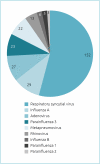Evaluation of Severe Acute Respiratory Syndrome surveillance caused by respiratory viruses in a pediatric unit, 2013 to 2019
- PMID: 37646750
- PMCID: PMC10503425
- DOI: 10.1590/1984-0462/2024/42/2022215
Evaluation of Severe Acute Respiratory Syndrome surveillance caused by respiratory viruses in a pediatric unit, 2013 to 2019
Abstract
Objective: To evaluate severe acute respiratory syndrome surveillance in a pediatric unit.
Methods: Descriptive study of reported severe acute respiratory syndrome cases with the detection of respiratory viruses in the nasopharyngeal sample of patients hospitalized between 2013 and 2019, in a reference hospital in the Federal District, Brazil.
Results: A total of 269 children had one or more viruses detected, resulting in 280 viruses, of which 152 (54%) were respiratory syncytial virus. The detection of respiratory syncytial virus was higher during the autumn-winter period. Children´s median age was 6.9 months, 156 (58%) were male, 104 (39%) had comorbidity, 197 (73%) required mechanical ventilation, 241 (90%) received antibiotics, and 146 (54%) oseltamivir. There were 19 (7%) deaths. The median time from symptom onset to sample collection was 5 days and the median time from sample collection to final results was 6 days.
Conclusions: The system needs to reduce the time to deliver results so that inappropriate use of antibiotics and antivirals can be avoided. Moreover, the burden of viral pneumonia was relevant and the system must be flexible enough to include emerging viruses in order to be useful in responding to public health emergencies caused by respiratory viruses.
Objetivo:: Avaliar a vigilância da síndrome respiratória aguda grave em uma unidade pediátrica.
Métodos:: Estudo descritivo dos casos de síndrome respiratória aguda grave, notificados e com a detecção de vírus respiratório em amostra de nasofaringe de pacientes internados entre 2013 e 2019, em um hospital de referência do Distrito Federal.
Resultados:: Um total de 269 crianças tiveram algum vírus detectado, resultando em 280 vírus, sendo 152 (54%) vírus sincicial respiratório. A detecção do vírus sincicial respiratório foi maior durante o período de outono-inverno. A mediana da idade das crianças foi de 6,9 meses, 156 (58%) eram do sexo masculino, 104 (39%) tinham comorbidade, 197 (73%) necessitaram de ventilação mecânica, 241 (90%) receberam antibióticos e 146 (54%) oseltamivir. Ocorreram 19 (7%) óbitos. A mediana do tempo desde o início dos sintomas até a coleta da amostra foi de 5 dias, e do tempo da coleta até o resultado foi de 6 dias.
Conclusões:: O sistema necessita reduzir o tempo do resultado final para que seja possível evitar o uso inadequado de antibióticos e antivirais. Ademais, o impacto das pneumonias virais foi relevante e o sistema deve ser flexível suficiente para incluir vírus emergentes, para ser útil na resposta às emergências de saúde pública causada por vírus respiratórios.
Conflict of interest statement
The authors declare there is no conflict of interests.
Figures
References
-
- Shi T, McAllister DA, O’Brien KL, Simoes EA, Madhi SA, Gessner BD, et al. Global, regional, and national disease burden estimates of acute lower respiratory infections due to respiratory syncytial virus in young children in 2015: a systematic review and modelling study. Lancet. 2017;390:946–958. doi: 10.1016/S0140-6736(17)30938-8. - DOI - PMC - PubMed
MeSH terms
Substances
LinkOut - more resources
Full Text Sources



